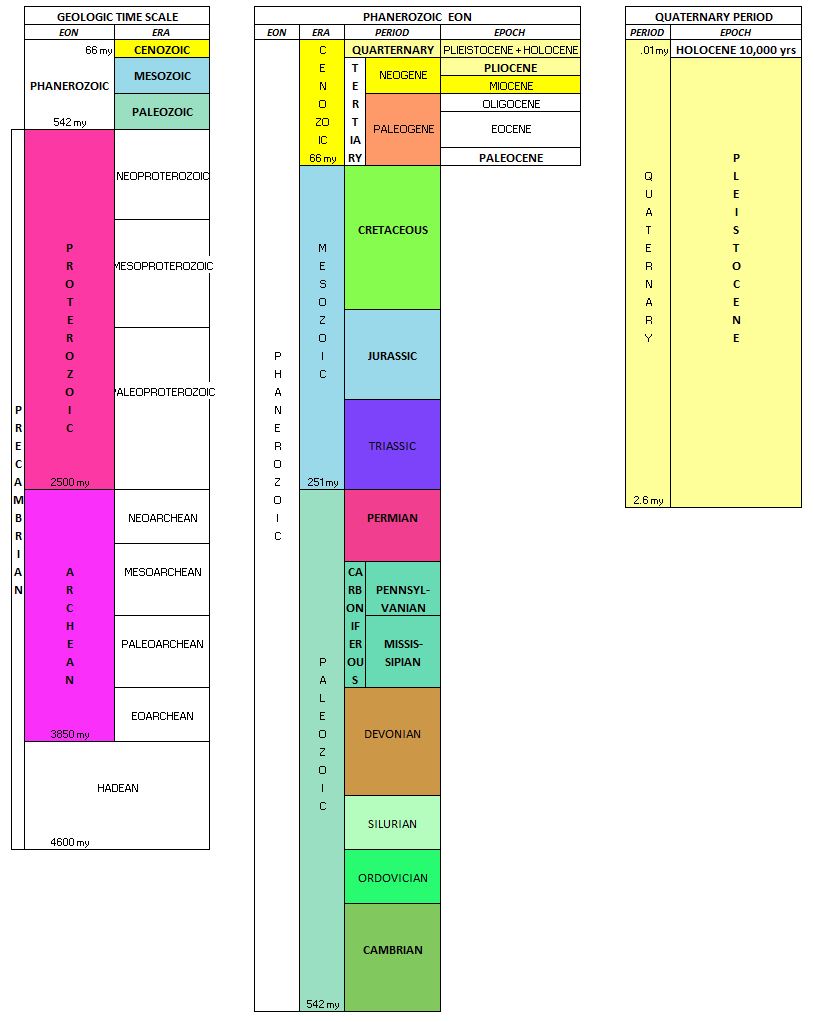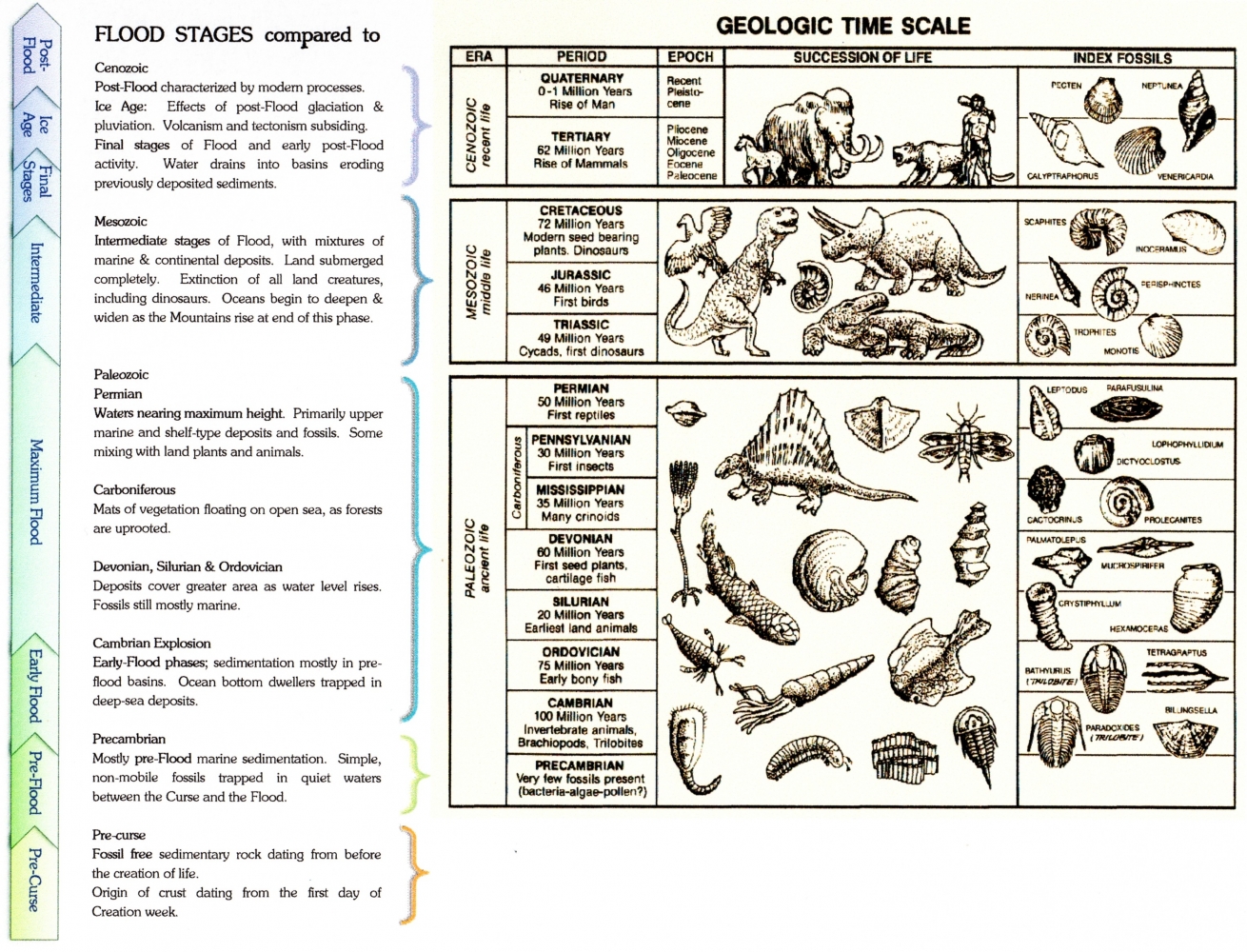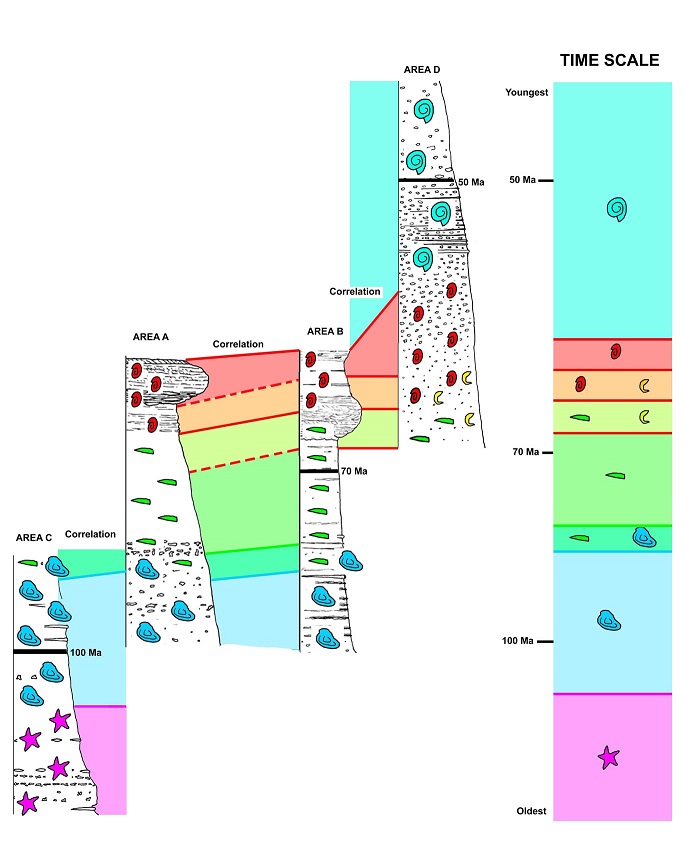WayneODonnell.com
Young Earth or Old Earth?
Creation:
https://answersingenesis.org/answers/books/universe-by-design/
Anti-Creation: http://talkorigins.org/origins/faqs-index.html
Intelligent Design
Man vs. Cat vs. Inanimate
Forest vs. Garden, Bedroom
Astronomy
The Big Bang
Dopler Effect
Red Shift
Hubble Constant
Speed of Light and Inflation
Cosmic Microwave Backgroud (CMB)
Anthropic Principle
Spiral Galaxies

Geology
The Geologic Column Model
The Geologic Column Observed
Wikipedia: The geologic record is in no one place entirely
complete," https://en.wikipedia.org/wiki/Geologic_record.
Creationist Site: Approximately 77% of the earth's surface area on
land and under the sea has seven or more (70% or more) of
the strata systems missing beneath; 94% of the earth's surface has three
or more systems missing beneath; and an estimated 99.6% has at
least one missing system.2 Only a few locations
on earth (about 0.4% of its area) have been described with the
succession of the ten systems beneath (west Nepal, west Bolivia, and
central Poland). Even where the ten systems may be present,
geologists recognize individual systems to be incomplete. The entire
geologic column, composed of complete strata systems, exists only in
the diagrams drawn by geologists!
http://www.icr.org/article/ten-misconceptions-about-geologic-column/
Geologic Column Correlation via Index Fossils (see
Geologic Column Model Chart)
Radiometric Dating
Like uranium to lead. Cannot be used directly to
on sedimentary rock. "After one
half-life has elapsed, one half of the atoms of the nuclide in
question will have decayed into a "daughter" nuclide. ...If a
material that selectively rejects the daughter nuclide is heated,
any daughter nuclides that have been accumulated over time will be
lost through diffusion, setting the isotopic "clock" to zero. The
temperature at which this happens is known as the closure
temperature or blocking temperature and is specific to a particular
material and isotopic system. These temperatures are experimentally
determined in the lab by artificially resetting sample minerals
using a high-temperature furnace. As the mineral cools, the crystal
structure begins to form and diffusion of isotopes is less easy. At
a certain temperature, the crystal structure has formed sufficiently
to prevent diffusion of isotopes. This temperature is what is known
as closure temperature and represents the temperature below which
the mineral is a closed system to isotopes. Thus an igneous or
metamorphic rock or melt, which is slowly cooling, does not begin to
exhibit measurable radioactive decay until it cools below the
closure temperature. The age that can be calculated by radiometric
dating is thus the time at which the rock or mineral cooled to
closure temperature."
https://en.wikipedia.org/wiki/Radiometric_dating "The advantage of
isochron dating as compared to simple radiometric dating techniques
is that no assumptions are needed about the initial amount of the
daughter nuclide in the radioactive decay sequence. Indeed the
initial amount of the daughter product can be determined using
isochron dating. This technique can be applied if the daughter
element has at least one stable isotope other than the daughter
isotope into which the parent nuclide decays."
http://en.wikipedia.org/wiki/Isochron_dating
Carbon-14 Dating
Wikipedia: "Radiocarbon dating (also referred to as carbon dating or
carbon-14 dating) is a method of determining the age of an object
containing organic material
by using the properties of radiocarbon ... used to calculate when
the animal or plant died. The older a sample is, the less C14 there
is to be detected, and because the half-life of C14 (the period of
time after which half of a given sample will have decayed) is about
5,730 years, the oldest dates that can be reliably measured by
radiocarbon dating are around 50,000 years ago. ... During
its life, a plant or animal is exchanging carbon with its
surroundings, so the carbon it contains will have the same
proportion of 14
C as
the atmosphere. ... The above calculations make several
assumptions, such as that the level of C14 in the atmosphere has
remained constant over time. In fact, the level of C14 in the
atmosphere has varied significantly and as a result the values
provided by the equation above have to be corrected by using data
from other sources. This is done by calibration curves."
http://en.wikipedia.org/wiki/Radiocarbon_dating
The Cambrian Explosion
Wikipedia: "Many of the present phyla appeared during this period,
with the exception of Bryozoa, which made its earliest known
appearance in the Lower Ordovician. The Cambrian explosion has
generated extensive scientific debate. The seemingly rapid
appearance of fossils in the “Primordial Strata” was noted as early
as the 1840s, and in 1859 Charles Darwin discussed it as one of the
main objections that could be made against the theory of evolution
by natural selection. ... In On the Origin of
Species, Charles Darwin considered this sudden appearance of
solitary group of trilobites with no apparent antecedents, and
absence of other fossils to be "undoubtedly of the gravest nature"
among the difficulties in his theory of natural selection. He
reasoned that earlier seas had swarmed with living creatures, but
that their fossils had not been found due to the imperfections of
the fossil record. In the sixth edition of his book, he stressed his
problem further as: "To the question why we do not find rich
fossiliferous deposits belonging to these assumed earliest periods
prior to the Cambrian system, I can give no satisfactory answer."
http://en.wikipedia.org/wiki/Cambrian_explosion
Lagerstätten
Wikipedia: A Lagerstätte (from German, Lager 'storage' Stätte
'place') is a sedimentary deposit that exhibits extraordinary
fossils with exceptional preservation—sometimes including preserved
soft tissues. http://en.wikipedia.org/wiki/Lagerst%C3%A4tte
Burgess Shale, Canadian Rockies of British Columbia, Middle Cambrian
Maotianshan Shales (Chengjiang), Yunnan Province, China, Early
Cambrian
Wheeler Shale (House Range), Western Utah, US, Early Cambrian
Meyer - Creationism:
http://www.discovery.org/articleFiles/PDFs/Cambrian.pdf
Meyer SC (2013). Darwin's Doubt: The Explosive Origin of Animal Life
and the Case for Intelligent Design. HarperOne. ISBN 978-0062071477
Meyer SC (2009). Signature in the cell: DNA and the evidence for
intelligent design. HarperOne. ISBN 0-06-147278-6.
Punctuated Equilibrium
Extinction Events
The Ice Age
History - Rise of Civilization, Agricultural Revolution,
Bristlecone Tree Rings, Ice Cores, Pleistocene/Holocene
Boundry,
Language
In phonetics, vowel reduction is any of various changes in the
acoustic quality of vowels, ... which are perceived as "weakening".
It most often makes the vowels shorter.
https://en.wikipedia.org/wiki/Vowel_reduction. In linguistics,
specifically phonetics and phonology, schwa (sometimes spelled
shwa)[1] refers to the mid-central vowel sound (rounded or
unrounded) in the middle of the vowel chart, denoted by the IPA
symbol ə, or another vowel sound close to that position.
https://en.wikipedia.org/wiki/Schwa.
In phonology, syncope (/ˈsɪŋkəpiː/; Greek: syn- + koptein "to
strike, cut off") is the loss of one or more sounds from the
interior of a word, especially the loss of an unstressed vowel.
https://en.wikipedia.org/wiki/Syncope_(phonology)
In grammar, inflection or inflexion is the modification of a word to
express different grammatical categories such as tense, mood, voice,
aspect, person, number, gender and case. The inflection of verbs is
also called conjugation, and the inflection of nouns, adjectives and
pronouns is also called declension.
Elision or deletion is the omission of one or more sounds (such as a
vowel, a consonant, or a whole syllable) in a word or phrase.
English: comfortable
/ˈkʌmfərtəbəl/ /ˈkʌmftərbəl/
Japanese: Matsushita-san wa imasu ka? ("Is Mr. Matsushita
in?") Pronounced: matsush'tasanwa imas'ka
Apocope (/əˈpɒkəpiː/) is the loss of one or more sounds from the end
of a word, and especially the loss of an unstressed vowel.
https://en.wikipedia.org/wiki/Apocope
Syncope (Greek: syn- + koptein "to strike, cut off") is the loss of
one or more sounds from the interior of a word, especially the loss
of an unstressed vowel.
Synchronic:
In Inflections: Imir (To play) should become *"imirím" (I play).
Imir becomes Imrím.
In informal speech: English did n[o]t > di[d]n't (with apostrophe
= contractions)
Diachronically
English Worcester, pronounced /ˈwʊstər/
Latin cál[i]dum > Italian caldo "hot"
Inflection
Because the Proto-Indo-European language was highly inflected, all
of its descendant Indo-European languages, such as Albanian,
English, German, Russian, Persian, Kurdish, Italian, Irish, Spanish,
French, Hindi, Marathi, Urdu, Bengali, and Nepali, are inflected to
a greater or lesser extent. In general, older Indo-European
languages such as Latin, Ancient Greek, Old English, Old Norse, and
Sanskrit are extensively inflected because of their temporal
proximity to Proto-Indo-European. Deflexion has caused modern
versions of some Indo-European languages that were previously highly
inflected to be much less so; an example is Modern English, as
compared to Old English. In general, languages where deflexion
occurs replace inflectional complexity with more rigorous word
order, which provides the lost inflectional details.
Old English was a moderately inflected language, using an extensive
case system similar to that of modern Icelandic or German. Middle
and Modern English lost progressively more of the Old English
inflectional system. Modern English is considered a weakly inflected
language.
2nd person Old English - Nom., Obj., Gen., Pos.
singular thou thee
thy thine
plural
ye you
your yours
2nd person Modern English
singular you you
your yours
plural you
you your yours
Latin, the mother tongue of the Romance languages, was highly
inflected; nouns and adjectives had different forms according to
seven grammatical cases (including five major ones) with five major
patterns of declension, and three genders instead of the two found
in most Romance tongues. There were four patterns of conjugation in
six tenses, three moods (indicative, subjunctive, imperative, plus
the infinitive, participle, gerund, gerundive, and supine) and two
voices (passive and active), all overtly expressed by affixes
(passive voice forms were periphrastic in three tenses).
Old Norse was inflected, but modern Swedish, Norwegian, and Danish
have, like English, lost almost all overt inflection.
Genetics - Mitochondrial Eve



